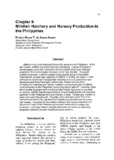Milkfish hatchery and nursery production in the Philippines
Share
Abstract
Milkfish is the most important farmed fish species in the Philippines. In the last 5 years, milkfish production has been increasing. Culture of milkfish in brackishwater ponds still contributes most to milkfish production, although production from marine cages has been on the rise, recently. To sustain milkfish production, a reliable supply of good quality seeds is imperative. Following the spontaneous spawning of milkfish in floating net cages in 1979, protocols for broodstock management, breeding and seed production were developed and these have been continuously refined over the years. Compared to Indonesia and Taiwan, however, commercialization of milkfish seed production in the Philippines, took a long time to take off. Currently, there are a number of government-run and private milkfish hatcheries in operation. In contrast, milkfish fingerling production in brackishwater ponds has long been practiced in the Philippines and is an industry in itself. Traditionally, milkfish fry were from catch from the wild. Recently, more and more come from local hatcheries as well as fry imported from neighboring countries like Indonesia and Taiwan. Prospects for the milkfish hatchery and nursery industries are discussed in light of the Philippine government initiatives to increase fish production, including milkfish, through mariculture as well as by improving production efficiency in other traditional culture systems.
Suggested Citation
de Jesus-Ayson, E. G. T. (2010). Milkfish hatchery and nursery production in the Philippines. In I. C. Liao & E. M. Leaño (Eds.), Milkfish aquaculture in Asia (pp. 61-70). Keelung, Taiwan: National Taiwan Ocean University, The Fisheries Society of Taiwan, Asian Fisheries Society and World Aquaculture Society.


